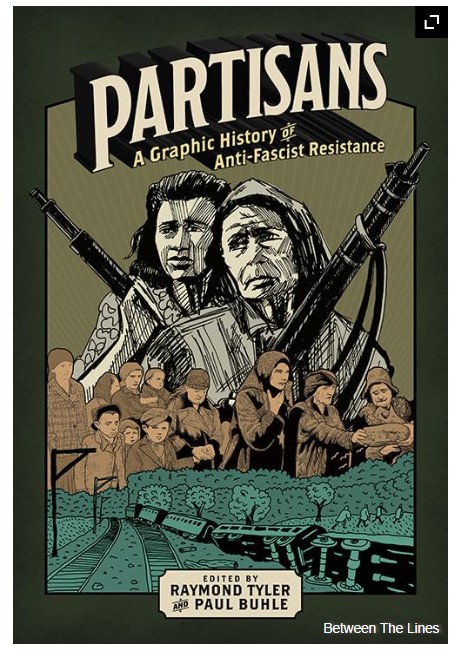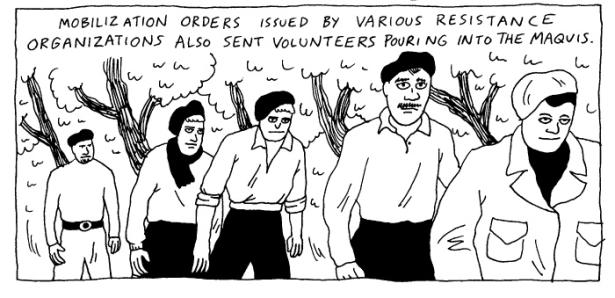I am writing this review from the Czech Republic, where I am visiting for the fall semester at Masaryk University. In the months before leaving for my trip, I attended weekly protests in Los Angeles and Culver City, California, against the encroach of fascism in the United States, as led by President Donald Trump and abetted by his absurd and obsequious cabinet and advisors, the United States Supreme Court, billionaire industrialists and speculators, and right-wing media figures. Now, I find myself in the proximity of a number of fascist-minded dictators, including Viktor Orban in Hungary, Recep Erdogan in Turkey, Ilham Aliyev in Azerbaijan, and above all, Vladimir Putin in Russia.
What guidance, if any, can the legacy of the many partisan military groups who resisted occupation forces in their nations during World War II offer us at this uncertain moment? History does not repeat itself, as many scholars have noted, but disconcerting similarities may sometimes emerge. Still, it is clear that past eras of partisan warfare lack tactical application in the United States, where left resistance cannot prevail militarily due to the right’s near-total monopoly on weaponry.
Partisans: A Graphic History of Anti-Fascist Resistance
Edited by Raymond Tyler and Paul Buhle
Between The Lines; 148 pages
August, 2025
Paperback: $34.95; E-book: $33.99
ISBN 9781771136525 and ISBN 9781771136983

But as radical historian Paul Buhle and comics writer Raymond Tyler demonstrate with their new comic art collection, Partisans: A Graphic History of Anti-Fascist Resistance, stories of partisan resistance can offer inspiration for those opposing fascism even when their military tactics are not directly replicable. Like their many distinguished predecessors—including World War II-era comic artists such as Harvey Kurtzman, Jack Davis, and Wally Wood, whose influence the editors cite in the book’s afterword—Partisans’s contributors craft striking visual art alongside their insightful commentary about the bravery and courage of women and men who fought and died fighting fascism throughout World War II.
Buhle and Tyler have selected outstanding visual artists and storytellers to chronicle the resisters who fought the Nazi invaders in Europe. The artistic styles are diverse, but will prove engaging for any reader who wants to learn more about the hidden histories of anti-fascist struggle.
Partisans is uniquely valuable in part because this history has been tragically overlooked. Many older progressives, for example, may know a great deal about the brigades of heroic foreign citizens who volunteered to fight against fascist takeover in Spain in the late 1930s—particularly the American battalions, known collectively as the Abraham Lincoln Brigade. But as I can attest from my experience teaching at the University of California Los Angeles for more than forty years, younger generations are mostly unaware of that story. Very few of my students have even heard of the Spanish Civil War, much less the unsuccessful armed resistance to Francisco Franco’s fascist rebellion against the Spanish Republic. Artist Sharon Rudahl brings the anti-fascists’s story to life in Partisans with her colorful, engaging two-page illustrations, depicting their grit and determination as members of the International Brigade moved on from their defeat in 1939 to fight the Nazis in France, Italy, Greece, Yugoslavia, and elsewhere in Europe.
Many of the collection’s other stories will be new to a wide variety of readers—even longtime progressives who, like me, study and teach about the history of resistance. Writer Sander Feinberg and artist Summer McClinton, for example, have collaborated on a revealing capsule history of those who resisted Nazi occupiers in Hungary. Their efforts to protect Hungarian Jews from capture took many forms, including forged documents and underground hiding places to harbor people as they attempted to flee the country. Despite their efforts, more than 400,000 Hungarian Jews were captured and deported to Auschwitz, where most were murdered. Even so, a few brave resisters continued to forge documents and bribe Nazi and Hungarian collaborationist officials to remove some people from danger.
Although the history of the French Resistance during World War II is comparatively well known, Daniel Selig’s chapter, “Freedom or Death,” highlights the underrecognized role of the French Communist Party in the years of struggle against Nazi domination. Many veterans of the International Brigades in Spain helped form one of the nuclei of the French armed resistance, a communist group called the Special Organization (or “OS”) that later merged with other partisans to form the Francs-tireurs et Partisans. Their collective efforts to hinder the German occupiers included audacious military actions such as blowing up trains and bridges, sabotage operations, and intellectual work such as underground newspapers and anti-fascist art, cinema, and music. The expertise of the former Spanish Civil War fighters, many of them communists, proved instrumental in these efforts.
But alongside their successes, Selig also depicts the divisions that arose within the French Resistance. Despite their heroic and effective efforts, many communist French Resistance members were shunned and even persecuted after the war’s end, as they fought for postwar reforms such as women’s suffrage, social security, and the nationalization of key economic institutions. This chapter of history is rarely taught in U.S. institutions. The clarity with which Selig’s black-and-white art style conveys the narrative validates Buhle and Tyler’s decision to include a diversity of visual styles in the collection, including those with color panels, highly detailed imagery, and greater focus on text than a traditional comic-strip format.
Another chapter by veteran political artist Seth Tobocman combines vibrant visual imagery with powerful historical text to tell the story of Yugoslav Communist Party leader Josip Broz Tito, who organized the most effective anti-Nazi resistance in Europe. He depicts how Tito unified a region made up of vastly different nationalities and cultures under one banner—a vision of multiculturalism that lasted through his long reign in Yugoslavia, which ended with his death in 1980. This strikingly illustrated chapter also includes scenes of the Nazis’s retaliation against partisan successes, including graphic images of mass executions of innocent civilians, which were common throughout Europe. Tobocman ends his chapter by considering the aftermath of Tito’s death, during which Yugoslavia split into seven separate nations through a period of nationalistic violence and ethnic cleansing. The partisans helped defeat the Nazis, Tobocman grants—but was the multicultural tolerance Tito fostered in Yugoslavia real, or a fleeting illusion?
Subsequent chapters provide readers and viewers a window into partisan activities in Italy, Greece, Holland, and parts of Eastern Europe, as well as in the Soviet Union. Across the occupied nations, partisan resistance efforts included sabotage, strikes, and targeted assassinations of Nazis and their collaborators. Alongside these actions, the collection also depicts the many cruel atrocities perpetrated by the Nazis against civilians.
Across its vivid storytelling and illustrations, Partisans centers the individual heroism of the everyday people, including many young women and Jews, who engaged in anti-fascist resistance throughout Europe—and who, in too many cases, died in their struggles for liberation. Partisans gives them each a human face, reminding us that resistance against oppression requires both personal and communal bravery and commitment—qualities that the majority of Europeans failed to evince in the moment. Their stories offer both a lesson and a warning for us in the present: It highlights the need for resistance against fascism in whatever ways our circumstances allow us. In the United States, that means something very different from wartime Spain, Italy, Hungary, Yugoslavia, France, and the other occupied nations.
We have no alternative. And time is short. We should admire the heroes of Partisans and proceed to blaze our own path to silence and then defeat the march of fascism in the twenty-first century. How we do so is our urgent challenge.
[Paul Von Blum is senior lecturer in African American Studies and Communication at UCLA. He is a longtime civil rights and political activist and the author of many books and articles on political art, expressive culture, education, and law.]


Spread the word